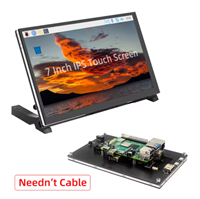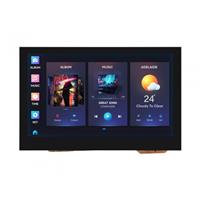Ken Yap
AUSTRALIA • + Follow
Edit Project
Tools, APP Software Used etc.

|
KiCADKicad
|
Description
3 line to 32 line output expander
This project is described at Hackaday.
The minimum lines required to use this board are: GND, SER (data), SRCLK (shift), RCLK (strobe). Vcc depends on the power arrangement. You should jumper the ~OESEL (output enable select) to ground if you don't wish to disable the display by signal, or vary the output with PWM, from a controller. The ~SRCLR input is only needed for resetting the output by the controller.
This board is designed with optional aspects you can choose to include or not:
- As mentioned some lines don't need to be driven in smaller configurations.
- Between 1 and 4 74HC595s can be installed for 8-32 outputs, in steps of 8. Naturally only the resistors for the used outputs need to be installed.
- The 74HC595 can source or sink 6 mA current.
- The 74HC595 can operate between 2V and 6V. This can be chosen to suit the controller, e.g. 3.3V or 5V, and the power supply section if installed.
- The power supply section is optional. You can choose to power this from the controller. Or you could power the controller with this.
- Copper pads for data and output are duplicated so you can attach more connectors or even solder wires. The input power is also brought out to duplicate pads for piggybacking to other circuits, e.g. an auxiliary board.
- Although the connectors are rendered as vertical pin headers, you can use other kinds of connectors like pin sockets, or even solder wires to the pads.
Mar 04,2022
1,356 views
end-flag
3 line to 32 line output expander
2 Layers PCB 91.44 x 96.52 mm FR-4, 1.6 mm, 1, HASL with lead, Green Solder Mask, White silkscreen
Don't have enough output lines on your microcontroller? With this you can expand 3 lines to 32.
1356
3
2
Published: Mar 04,2022
Download Gerber file 29
Purchase
Donation Received ($)
PCBWay Donate 10% cost To Author
*PCBWay community is a sharing platform. We are not responsible for any design issues and parameter issues (board thickness, surface finish, etc.) you choose.
Copy this HTML into your page to embed a link to order this shared project
Copy
Under the
Attribution-ShareAlike (CC BY-SA)
License.

Raspberry Pi 5 7 Inch Touch Screen IPS 1024x600 HD LCD HDMI-compatible Display for RPI 4B 3B+ OPI 5 AIDA64 PC Secondary Screen(Without Speaker)
BUY NOW
ESP32-S3 4.3inch Capacitive Touch Display Development Board, 800×480, 5-point Touch, 32-bit LX7 Dual-core Processor
BUY NOW
Raspberry Pi 5 7 Inch Touch Screen IPS 1024x600 HD LCD HDMI-compatible Display for RPI 4B 3B+ OPI 5 AIDA64 PC Secondary Screen(Without Speaker)
BUY NOW- Comments(2)
- Likes(3)
-
 Anthony Pedotto
Feb 22,2025
Anthony Pedotto
Feb 22,2025
-
 Engineer
Mar 11,2024
Engineer
Mar 11,2024
-
 Mr Eddie Bannister
Mar 18,2022
Mr Eddie Bannister
Mar 18,2022
View More
VOTING
0 votes
- 0 USER VOTES
0.00
- YOUR VOTE 0.00 0.00
- 1
- 2
- 3
- 4
- 5
- 6
- 7
- 8
- 9
- 10
Design
1/4
- 1
- 2
- 3
- 4
- 5
- 6
- 7
- 8
- 9
- 10
Usability
2/4
- 1
- 2
- 3
- 4
- 5
- 6
- 7
- 8
- 9
- 10
Creativity
3/4
- 1
- 2
- 3
- 4
- 5
- 6
- 7
- 8
- 9
- 10
Content
4/4
 More by Ken Yap
More by Ken Yap
-
 3 line to 32 line output expander
This project is described at Hackaday.The minimum lines required to use this board are: GND, SER (da...
3 line to 32 line output expander
This project is described at Hackaday.The minimum lines required to use this board are: GND, SER (da...
-
 3 line to 32 line output expander - SMT version
This project is described at Hackaday.The minimum lines required to use this board are: GND, SER (da...
3 line to 32 line output expander - SMT version
This project is described at Hackaday.The minimum lines required to use this board are: GND, SER (da...
-
 Inch digits
I decided to find out how large a 4-digit LED display I could fit into a budget 100x100 mm PCB, and ...
Inch digits
I decided to find out how large a 4-digit LED display I could fit into a budget 100x100 mm PCB, and ...
-
 An uninnovative linear LED display
BackgroundAfter finishing my TTL clock I was aware of limitations of that design. Not only are the c...
An uninnovative linear LED display
BackgroundAfter finishing my TTL clock I was aware of limitations of that design. Not only are the c...
You may also like
-
-
Commodore 64 1541-II 1581 Floppy Disk Drive C64 Power Supply Unit USB-C 5V 12V DIN connector 5.25
182 1 3 -
Easy to print simple stacking organizer with drawers
89 0 0 -
-
-
-
Modifying a Hotplate to a Reflow Solder Station
1158 1 6 -
MPL3115A2 Barometric Pressure, Altitude, and Temperature Sensor
648 0 1 -
-
Nintendo 64DD Replacement Shell
498 0 2 -
V2 Commodore AMIGA USB-C Power Sink Delivery High Efficiency Supply Triple Output 5V ±12V OLED display ATARI compatible shark 100W
1469 4 3










































Sure, not just the RPi but any microcontroller. The trade-off is of course speed. It takes time to update the outputs from a serial stream, so you can change the output only so fast. But for many applications this is not an issue. I think up to hundreds of times a second is not a problem. Enjoy, and if you do any interesting projects with it, write it up on Hackaday.io.